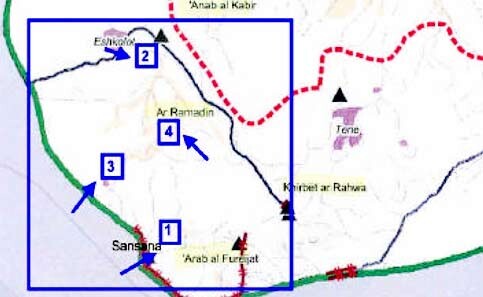United Nations Relief and Works Agency for Palestine Refugees in the Near East 20 July 2004

Map of Ramadin (UNRWA)
Ramadin village is located at the southern tip of the West Bank very close to the Green Line (see map, point 1). It is inhabited by 3,500 Bedouins, of whom 3,000 are registered refugees (330 families), mainly shepherds. UNRWA runs a school and a health clinic in the village; construction of a new UNRWA school is under way. According to official Israeli maps, after completion of the ‘Barrier’ this village will lie in the ‘seamzone’, between the Barrier and the Green Line (see red dotted line on map).
As with many other villages in the West Bank, most homes have been built without proper permits, although mostly on land owned by the residents. Since May 2004 there have been four rounds of demolition of homes and destruction of wells in the village and there are a number of pending demolition orders for more homes, shacks and wells. The refugees whose homes are destroyed move into the tents provided by UNRWA or with family and friends. Most wells destroyed or with demolition orders pending have been built since the beginning of this intifada to enable the residents to collect rainwater, because they cannot buy water from Israel as they have in the past.
Local people reported cases of harassment by the Israeli security forces, including visits by the IDF to the households which UNRWA has visited, where they demanded to know the reason for such visits and examine the assistance delivered.
UNRWA visits
1. On 17 May 2004, the UNRWA team visited the area in the village where three buildings had been demolished by the
***image3***Israeli Authorities for lack of building permits. The buildings were located close to the Eshkolot settlement (see map, point 2) although not adjacent to it.. Altogether, approximately fifty registered refugees (Jamaein family) were made homeless by this round of demolitions. Buildings closer to the settlement were left intact and the residents were told by the IDF that they would be back to demolish them too for lack of permits. The day after the houses were destroyed, UNRWA social workers visited the five families and distributed humanitarian items, including tents for the families to live in.
The families erected and moved into the tents. However, according to the Jamaein family, on 21 May, IDF soldiers entered the hamlet and told them that unless the tents were removed immediately, the remaining houses would be destroyed. The family felt that under the circumstances they had no choice but to acquiesce and reluctantly set about removing them. The tents are now stored in the chicken coup and the family have found a place to stay with a relative.
2. On 4 June 2004, the UNRWA team visited the Arab Mesamra neighbourhood (see map, point 3) where the IDF had demolished two homes for lack of building permits. In total, 30 people were made homeless from this demolition. There are demolition orders pending for all the buildings in this neighbourhood (approximately five). The IDF has warned the residents that they will be back to demolish the rest of the homes. The remaining residents amount to approximately 60 people. Border Police obstructed the passing of an UNRWA van with emergency kits, tents and food, delaying their arrival in Ramadin for fifty minutes. The two homes had been built in 1984 and 1992 respectively. The orders date from six months before the demolition. The settlement of Sansana which is located on a hilltop directly facing the Mesamra neighbourhood a kilometre away, lies half in Israel and half in the West Bank.
3. On 6 June the UNRWA team visited the Zagharneh family which comprises sixty refugees. For the past year the family has been trying to stop the demolition of the three wells in their neighbourhood. However, a court order was issued giving three days warning and on 3 June, bulldozers accompanied by Border Police and IDF soldiers destroyed the three wells and the previously clear water is now polluted with fallen masonry.
4. On 21 June, 28 more demolition orders and three days’ warning were given to Ramadin residents. The UNRWA teams visited on 22 June and 5 July. The mukhtar’s family, who are among those affected, has sought legal advice. On 4 July five homes were destroyed in the Al-Rodawani neighbourhood, in the South Eastern part of Ramadin (see map, point 4).
Conclusion
The village of Ramadin, already suffering from poverty related to the closures imposed after the intifada started in 2000, is facing a wave of home demolitions and well destruction. Under the pretext that these structures have been built without proper permits, the Israeli Authorities have left approximately 12 families (120 people) homeless and destroyed three wells: this despite the fact that it is virtually impossible for Palestinians to obtain building permits in this area. There are at least 30 pending demolition orders. If the route of the Barrier does not change, Ramadin, including the UNRWA school and clinic and the 3,000 registered refugees living in the village, will end up in the ‘seamzone’ and will need permits to live on their land and to access grazing land. There is a danger that those whose homes have been destroyed or have a pending demolition order will not receive residence permits.
Related Links